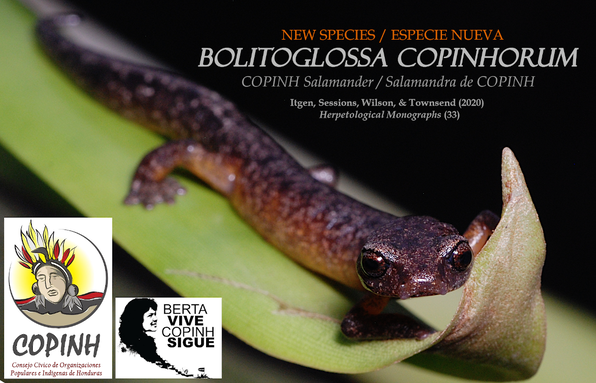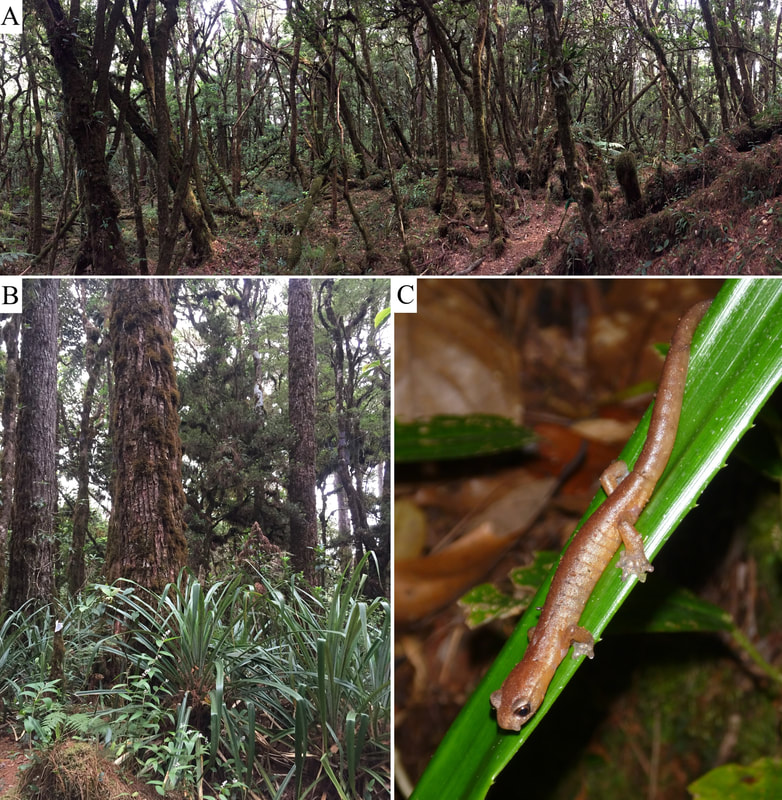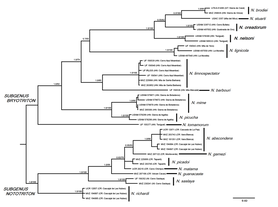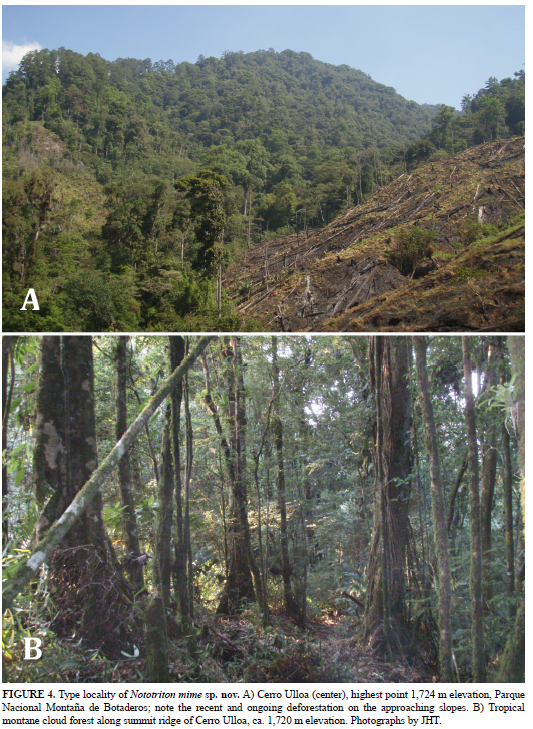Salamanders of the Chortis Highlands

Neotropical salamanders can be characterized by their high degree of diversification and widespread morphological conservatism and homoplasy. Diverse radiations of plethodontids are well documented in western Nuclear Central America (southern México and Guatemala) and southern Central America (Costa Rica and western Panama); however, much of this cryptic diversity has been revealed only recently by molecular studies. Like the better characterized areas of western Nuclear and southern Central America, the Chortís Highlands are a site of remarkable plethodontid diversity. The salamander fauna of the Chortis Highlands represent one of the richest (36 species) and most endangered (70+% threatened with extinction) components of the montane biota.
The Bolitoglossa (Magnadigita) dunni species group is a Chortís Highlands endemic radiation of 12 named species, and has the highest estimated rate of diversification of any major clade of Mesoamerican salamanders. Cryptic diversity and paraphyly in some named species, such as B. porrasorum, is currently being investigated in the Townsend Lab.
Moss salamanders of the genus Nototriton also represent an important component of the cloud forest fauna of the Chortís Highlands, with five endemic species inhabiting highland forests in eastern Guatemala and northern and central Honduras: N. barbouri, N. brodiei, N. lignicola, N. limnospectator, N. mime, N. picucha, N. stuarti, and N. tomamorum. Three of these species were discovered in the past few years by Dr. Townsend and associates, and at two additional new species are currently being described.
Worm salamanders (genus Oedipina) represent another challenging group of salamanders, due to their secretive fossorial habits and poor representation in collections. Recent work in Nicaragua has revealed a new species of the Chortís Highland endemic subgenus Oeditriton, O. nica, as well as a cryptic species, O. koehleri, previously referred to as O. pseudouniformis.

Integrative systematic revision of Bolitoglossa celaque McCranie & Wilson, with description of a new species from the Lenca Highlands of Honduras
Itgen, MW, SK Sessions, LD Wilson, and JH Townsend. 2020. Herpetological Monographs 33: 48–70. Download here
Lab alum Mike Itgen published his thesis research in the most recent issue of Herpetological Monographs, an integrative taxonomic revision of the salamander Bolitoglossa celaque that revealed eastern populations from the Lenca Highlands to be distinct from the population in Cerro Celaque.The study combined molecular, morphological, and osteological data, as well as previously published genome-size data, to delimit the new species, which we name Bolitoglossa copinhorum (= belonging to COPINH), to recognize the organization Consejo Cívico de Organizaciones Populares e Indígenas de Honduras (COPINH; ‘‘Council of Popular and Indigenous Organizations of Honduras’’), founded in March 1993 by Berta Caceres. COPINH is made up of representatives from over 200 indigenous Lenca communities across western Honduras, and seeks to defend and empower Lenca communities to resist exploitation of their lands and natural resources by outside interests. This new species is endemic to the remnant cloud forests of the Sierra Lenca in the departments of Intibucá and La Paz, and will immediately be classified as Endangered on the next update of the IUCN Red List.
Itgen, MW, SK Sessions, LD Wilson, and JH Townsend. 2020. Herpetological Monographs 33: 48–70. Download here
Lab alum Mike Itgen published his thesis research in the most recent issue of Herpetological Monographs, an integrative taxonomic revision of the salamander Bolitoglossa celaque that revealed eastern populations from the Lenca Highlands to be distinct from the population in Cerro Celaque.The study combined molecular, morphological, and osteological data, as well as previously published genome-size data, to delimit the new species, which we name Bolitoglossa copinhorum (= belonging to COPINH), to recognize the organization Consejo Cívico de Organizaciones Populares e Indígenas de Honduras (COPINH; ‘‘Council of Popular and Indigenous Organizations of Honduras’’), founded in March 1993 by Berta Caceres. COPINH is made up of representatives from over 200 indigenous Lenca communities across western Honduras, and seeks to defend and empower Lenca communities to resist exploitation of their lands and natural resources by outside interests. This new species is endemic to the remnant cloud forests of the Sierra Lenca in the departments of Intibucá and La Paz, and will immediately be classified as Endangered on the next update of the IUCN Red List.

Genome size diversification in Central American bolitoglossine salamanders (Caudata; Plethodontidae)
Itgen, MW, P Prša, R Janža, L Skubic, JH Townsend, A Kladnik, L Bizjak Mali, and SK Sessions. 2019. Copeia 107(3): 560–566. Download here
In a recent paper published in Copeia, lab alum Mike Itgen presented results of a collaborative project examining the genome sizes in six species of Honduran salmanders. Some take-aways from the paper include:
- Genome sizes in Bolitoglossa range from 42-84 picograms, a 42-pg range that is equivalent to the size of about 14 human genomes
- Six mountain-top endemic species have genomes larger than any previously reported for the genus Bolitoglossa OR for the family Plenthodontidae
- Nototriton picucha, a single site endemic from eastern Honduras, has a moderate-sized genome relative to the rest of the family Plethodontidae
- Our evidence from two sister lineages (B. celaque A and B) suggest genome size increases can occur rapidly and independently from changes in sequence structure of functional genes
- Our evidence from Bolitoglossa (Nanotriton) nympha supports the presence of enucleated RBCs as a synapomorphy for the miniaturized subgenus Nanotriton
Itgen, MW, P Prša, R Janža, L Skubic, JH Townsend, A Kladnik, L Bizjak Mali, and SK Sessions. 2019. Copeia 107(3): 560–566. Download here
In a recent paper published in Copeia, lab alum Mike Itgen presented results of a collaborative project examining the genome sizes in six species of Honduran salmanders. Some take-aways from the paper include:
- Genome sizes in Bolitoglossa range from 42-84 picograms, a 42-pg range that is equivalent to the size of about 14 human genomes
- Six mountain-top endemic species have genomes larger than any previously reported for the genus Bolitoglossa OR for the family Plenthodontidae
- Nototriton picucha, a single site endemic from eastern Honduras, has a moderate-sized genome relative to the rest of the family Plethodontidae
- Our evidence from two sister lineages (B. celaque A and B) suggest genome size increases can occur rapidly and independently from changes in sequence structure of functional genes
- Our evidence from Bolitoglossa (Nanotriton) nympha supports the presence of enucleated RBCs as a synapomorphy for the miniaturized subgenus Nanotriton

Taxonomic revision of Nototriton barbouri (Schmidt) (Caudata: Plethodontidae), with description of two new species of moss salamanders from the Cordillera Nombre de Dios, Honduras
Townsend, JH. 2016. Zootaxa 4196(4): 511–528.
Abstract: Moss salamanders (genus Nototriton) are represented in northern Central America by nine putative species: N. barbouri, N. brodiei, N. lignicola, N. limnospectator, N. mime, N. picucha, N. saslaya, N. stuarti, and N. tomamorum. I estimate the phylogenetic relationships for these species based on data from three mitochondrial gene fragments (16S, cytochrome b, and COI), and compare morphological variation among putative taxa. As evidenced here and in previous studies, the taxon N. barbouri is paraphyletic with respect to populations from the Cordillera Nombre de Dios in northern Honduras. I restricted this taxon to populations from the Sierra de Sulaco in central Yoro, Honduras, and describe two new species from the Cordillera Nombre de Dios.
Townsend, JH. 2016. Zootaxa 4196(4): 511–528.
Abstract: Moss salamanders (genus Nototriton) are represented in northern Central America by nine putative species: N. barbouri, N. brodiei, N. lignicola, N. limnospectator, N. mime, N. picucha, N. saslaya, N. stuarti, and N. tomamorum. I estimate the phylogenetic relationships for these species based on data from three mitochondrial gene fragments (16S, cytochrome b, and COI), and compare morphological variation among putative taxa. As evidenced here and in previous studies, the taxon N. barbouri is paraphyletic with respect to populations from the Cordillera Nombre de Dios in northern Honduras. I restricted this taxon to populations from the Sierra de Sulaco in central Yoro, Honduras, and describe two new species from the Cordillera Nombre de Dios.

Microsympatry in cryptic lowland salamanders (Caudata: Plethodontidae: Bolitoglossa subgenus Nanotriton) from northwestern Honduras: implications for taxonomy and regional biogeography
Hess, AJ, MW Itgen, TJ Firneno, JC Nifong, and JH Townsend. 2016. Journal of Zoological Systematics and Evolutionary Research (Online Early): doi:10.1111/jzs.12151.
Abstract: The taxonomy of the diminutive bolitoglossine salamanders of the subgenus Nanotriton has previously been a source of confusion among specialists. At various times, at least three different species of Nanotriton have been reported to occur in Honduras: Bolitoglossa nympha, B. occidentalis, and B. rufescens. Phylogenetic analysis of 16S and cyt b from samples from three localities in Honduras (departments of Yoro, Copán, and Cortés) confirm that most populations are assignable to B. nympha. Nine samples collected from a single locality on the northern slope of the Sierra de Omoa, between 120–190 m in elevation, were found to represent two distinct taxa: B. nympha and B. rufescens. Field examination of these nine specimens found them to be morphologically indistinguishable, including a lack of maxillary teeth in all specimens. As such in situ identification of the two species in northwestern Honduras is problematic given the occurrence of the two taxa in microsympatry in at least one locality. The discovery of yet another divergent lineage of B. rufescens highlights the need for a taxonomic reassessment within this species complex.
Hess, AJ, MW Itgen, TJ Firneno, JC Nifong, and JH Townsend. 2016. Journal of Zoological Systematics and Evolutionary Research (Online Early): doi:10.1111/jzs.12151.
Abstract: The taxonomy of the diminutive bolitoglossine salamanders of the subgenus Nanotriton has previously been a source of confusion among specialists. At various times, at least three different species of Nanotriton have been reported to occur in Honduras: Bolitoglossa nympha, B. occidentalis, and B. rufescens. Phylogenetic analysis of 16S and cyt b from samples from three localities in Honduras (departments of Yoro, Copán, and Cortés) confirm that most populations are assignable to B. nympha. Nine samples collected from a single locality on the northern slope of the Sierra de Omoa, between 120–190 m in elevation, were found to represent two distinct taxa: B. nympha and B. rufescens. Field examination of these nine specimens found them to be morphologically indistinguishable, including a lack of maxillary teeth in all specimens. As such in situ identification of the two species in northwestern Honduras is problematic given the occurrence of the two taxa in microsympatry in at least one locality. The discovery of yet another divergent lineage of B. rufescens highlights the need for a taxonomic reassessment within this species complex.

A new species of Nototriton (Caudata: Plethodontidae) from Montaña de Botaderos National Park in northeastern Honduras
Townsend JH, M Medina-Flores, O Reyes–Calderón, and JD Austin. 2013. Zootaxa 3666(3): 358–368. Download here
A new species of moss salamander (genus Nototriton) is described from Montaña de Botaderos National Park in northeastern Honduras. The new species, Nototriton mime, is the first member of the genus known to exhibit sexual dichromatism, with males (top photo) being a pale yellow-brown and females (bottom photo) a darker mottled brown color that is typical of other species of Nototriton. The study was published in the journal Zootaxa, and the article is available here.
Currently the species is known only from the highest portion of Montaña de Botaderos, in a patch of cloud forest less than 300 hectares in total extent, and we estimate that less than 1,000 hectares of potential habitat is available to N. mime in about a dozen isolated cloud forest fragments.
This new species is named to honor our late friend Arquimides Gabriel Rosales Martinez, or “Mime” (pronounced me-may), a young Honduran biologist passionate about amphibians. Mime and his sister, Novy Hortensia Rosales Martinez, were killed by a drunken driver on 17 December 2010 in Tegucigalpa.
Townsend JH, M Medina-Flores, O Reyes–Calderón, and JD Austin. 2013. Zootaxa 3666(3): 358–368. Download here
A new species of moss salamander (genus Nototriton) is described from Montaña de Botaderos National Park in northeastern Honduras. The new species, Nototriton mime, is the first member of the genus known to exhibit sexual dichromatism, with males (top photo) being a pale yellow-brown and females (bottom photo) a darker mottled brown color that is typical of other species of Nototriton. The study was published in the journal Zootaxa, and the article is available here.
Currently the species is known only from the highest portion of Montaña de Botaderos, in a patch of cloud forest less than 300 hectares in total extent, and we estimate that less than 1,000 hectares of potential habitat is available to N. mime in about a dozen isolated cloud forest fragments.
This new species is named to honor our late friend Arquimides Gabriel Rosales Martinez, or “Mime” (pronounced me-may), a young Honduran biologist passionate about amphibians. Mime and his sister, Novy Hortensia Rosales Martinez, were killed by a drunken driver on 17 December 2010 in Tegucigalpa.

















